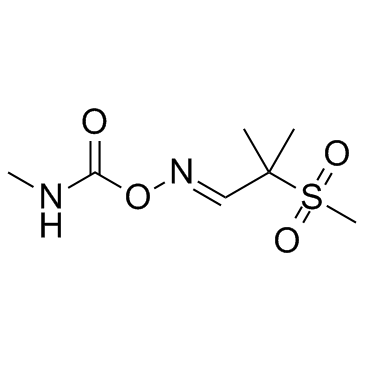Aldicarb (sulfone)

Aldicarb (sulfone) structure
|
Common Name | Aldicarb (sulfone) | ||
|---|---|---|---|---|
| CAS Number | 1646-88-4 | Molecular Weight | 222.262 | |
| Density | 1.2±0.1 g/cm3 | Boiling Point | N/A | |
| Molecular Formula | C7H14N2O4S | Melting Point | 132-135ºC | |
| MSDS | Chinese USA | Flash Point | N/A | |
| Symbol |


GHS06, GHS09 |
Signal Word | Danger | |
|
Determination of pesticides in soy-based infant formula using liquid chromatography with electrospray ionization tandem mass spectrometry.
J. AOAC Int. 89(1) , 214-24, (2006) A sensitive method using liquid chromatography with electrospray ionization tandem mass spectrometry (LC/ESI-MS/MS) was developed and validated to quantify and confirm 13 pesticides, including aldicarb sulfoxide, aldicarb sulfone, oxamyl, methomyl, formetanat... |
|
|
Persistence and metabolism of aldicarb in fresh potatoes.
Bull. Environ. Contam. Toxicol. 32(3) , 274-81, (1984)
|
|
|
[Gas chromatographic analysis of aldicarb and its metabolites in urine].
Zhonghua Yu Fang Yi Xue Za Zhi 25(3) , 136-8, (1991) A method is described for the analysis of aldicarb and its metabolites in urine by GC/FPD. The sample was concentrated with activated charcoal-Florisil column chromatography, eluted by dichloromethane-acetone (1:1v/v). The aldicarb, aldicarb sulfoxide in the ... |
|
|
Effects of four carbamate compounds on antioxidant parameters
Ecotoxicol. Environ. Saf. 72(3) , 922-30, (2009) The effect of four carbamates, aldicarb and its metabolites (aldicarb sulfone and aldicarb sulfoxide) and propoxur on glutathione content and the activity of the enzymes involved in the sulfur-redox cycle in the mammalian cellular model CHO-K1 cells after 24-... |
|
|
Aldicarb sulfoxide/aldicarb sulfone mixture in drinking water of rats: effects on growth and acetylcholinesterase activity.
J. Toxicol. Environ. Health A 16(2) , 163-72, (1985) A 1:1 mixture of aldicarb sulfoxide/aldicarb sulfone was administered to young adult Wistar rats via the drinking water at nominal concentrations of 19.2, 4.8, 1.2., 0.3, 0.075, or 0 ppm for 29 d. Blood was collected after 8, 15, and 29 d of treatment for pla... |
|
|
On-line trace enrichment for determination of aldicarb species in water, using liquid chromatography with post-column derivatization.
J. Assoc. Off. Anal. Chem. 69(6) , 985-9, (1986) Liquid chromatography combining on-line trace enrichment together with a very selective detection technique is used for the determination of aldicarb, aldicarb sulfoxide, and aldicarb sulfone. Sensitivity is increased by loading a 10 mL volume of ground water... |
|
|
Assessment of leaching potential of aldicarb and its metabolites using laboratory studies.
Pest Manag. Sci. 57(12) , 1135-41, (2001) The metabolites of pesticides can contaminate groundwater and pose a risk to human health when this water is used for drinking. This paper reports the results of a laboratory study on aldicarb and its main metabolites, aldicarb sulfone and aldicarb sulfoxide.... |
|
|
High pressure chromatography determination of aldicarb, aldicarb sulfoxide, and aldicarb sulfone in potatoes.
J. Assoc. Off. Anal. Chem. 64(3) , 724-8, (1981) An ion-suppression reverse phase high pressure liquid chromatographic method is described for the determination of aldicarb, aldicarb sulfoxide, and aldicarb sulfone in potatoes. Samples are extracted with methylene chloride and Na2SO4, evaporated to dryness,... |
|
|
Rapid on-line precolumn high-performance liquid chromatographic method for the determination of benomyl, carbendazim and aldicarb species in drinking water.
J. Chromatogr. A. 555(1-2) , 147-54, (1991) A reversed-phase high-performance liquid chromatographic (HPLC) method has been developed for the determination of trace concentrations of benomyl, carbendazim, aldicarb, aldicarb sulphoxide and aldicarb sulphone in drinking water. A 10-ml sample of water is ... |
|
|
Identification of degraded products of aldicarb due to the catalytic behavior of titanium dioxide/polyacrylonitrile nanofiber.
J. Chromatogr. A. 1216(36) , 6394-9, (2009) Photocatalytic properties of fibers containing TiO2 nanoparticles were explored for use as a self-decontaminating material using degradation of the pesticide aldicarb as the model toxin. During the analysis of the aldicarb treated sample by liquid chromatogra... |